Common menu bar links
Widowhood: Consequences on Income for Senior Women
Archived Content
Information identified as archived is provided for reference, research or recordkeeping purposes. It is not subject to the Government of Canada Web Standards and has not been altered or updated since it was archived. Please "contact us" to request a format other than those available.

by Chris Li
Income Statistics Division
Summary
Senior widows outnumber widowers four to one
Widowhood has direct impact on standard of living for senior women
Many senior women were in low income as a result of widowhood
Very difficult for senior widows to climb out of low income
Widows twice as likely to enter low income
At all income levels, income declined after widowhood
Sources of income change after widowhood
Summary
The death of a spouse can be one of life’s most traumatic situations, particularly for many older women who may have devoted most of their life to their husband and children.
Suddenly, many of them are alone, often for the first time ever since marriage. And suddenly, they have myriad decisions to make about their future, including key financial decisions. Surviving wives may be left more financially vulnerable.
For senior women aged 65 years and over between 1990 and 2001, the standard of living declined continuously for those who became widowed, while it remained relatively constant for their married counterparts. In this article, standard of living and family income refer to total family income before taxes adjusted for family size and composition in constant 2001 dollars.
Five years after they were widowed, median family income declined 9.8% for widows. This was more than six times greater than the 1.5% decline among senior women who remained married during the same time frame.
Not only did the standard of living of widows decline; more of them also fell below the low-income threshold as a result of widowhood. Five years after widowhood, 9.4% of widows were living in low income, almost three times higher than the proportion of women (3.6%) who were in low income in the year before they were widowed.
Although more women were living in low income after widowhood, many were clustered around the low-income threshold. This means that, on average, it would take a relatively small amount of money for each woman to lift them out of the low-income group.
Unfortunately, once these senior widows were in low income, it was very difficult for them to climb out.
One might think that women with the highest incomes would not be financially affected by the loss of a spouse. This was not the case, however. Senior women at all income levels incurred a decline in income after widowhood. Five years after widowhood, the 25% of senior women with the highest family incomes experienced a 7.5% decline.
Financial planning made by married couples, such as buying life insurance, can make a difference for the widow. Five years after widowhood, over one-third (36%) of widows experienced an increase in family income largely due to higher income from assets and other income, likely the result of such planning.
This article analyzes the impact of widowhood on income, as well as changes in the low-income rate and the sources of income among women 65 years of age and over between 1990 and 2001, using data from Statistics Canada’s Longitudinal Administrative Databank (LAD).
Senior widows outnumber widowers four to one
In 2001, Canada had just over 1.2 million widowed men and women aged 65 and over, a 6.4% increase from 1996, according to census data.
Senior widows outnumbered senior widowers four to one. In fact, widows accounted for 45% of all women aged 65 and over.1 With increased longevity, women will most likely live longer and live alone for considerable portions of their lives since women now live an average of 81.3 years, contrasted with 75.3 years for men. In addition, the pattern of population aging is projected to grow, for these seniors, from 13% in 2003 to 18% in 2021 with women predominating.2
This article will address an important question raised in a recent study by Statistics Canada, which found a relatively small decline in the real adjusted family income one year after the death of their husband in Canada. It stated that “... over the longer term, their situation could be quite different.”3 This study answers the longer term issue by following the income situation of the widows up to five years after their husbands’ death.
Note to readers
Canada’s retirement income system has three pillars: Old Age Security (OAS), Canada/Quebec Pension Plan (CPP/QPP) and private pensions and savings.
The first pillar is the OAS program, which is Canada’s largest public pension program for people starting at the age of 65. The Guaranteed Income Supplement (GIS) is an additional monthly benefit for low income OAS pensioners. Another part of the OAS program, the Allowance, which is available to the spouses or common-law partners of OAS pensioners, provides a monthly benefit to low income people between the ages of 60 and 64 to help bridge the gap until they become entitled to receive OAS at 65.
The Canadian Pension Plan (CPP) / Quebec Pension Plan (QPP) forms the second pillar. It pays a monthly retirement pension to people (as early as 60 years of age) who have worked and contributed to the CPP/QPP.
The third pillar is private pensions and savings, for which in most cases, the individual determines how much they will need in retirement and how it will be saved. Tax deductions on Registered Pension Plans (RPPs) and Registered Retirement Savings Plans (RRSPs) are the primary ways that the government assists individuals in saving for retirement.
Widowhood has direct impact on standard of living for senior women
Widowhood has a direct impact on the standard of living for senior women.
In this article, standard of living and family income refer to total family income before taxes adjusted for family size and composition in constant 2001 dollars. Income includes Old Age Security, pensions, other transfer payments, earnings, asset income and other income.
Median family income declined continuously among senior women who became widowed (aged 65 and over between 1990 and 2001), especially compared with women who remained married. (The median is the amount where one-half of the population is above, and the other half is below.)
The impact of widowhood was immediate. In the year before they were widowed, senior women had a median family income of $24,400. One year after they were widowed, this amount had declined 1.6% to $24,000. Among other senior married women, median family income remained unchanged at $26,800.
Based on these median values, it might be assumed that widowhood brings only a small change in living standards. However, five years down the road, median family income had fallen for both widows and senior women who remained married. Among widows, median family income declined 9.8%, more than six times greater than the 1.5% decline among senior women who did not become widows.
Median family income declined faster for senior widows
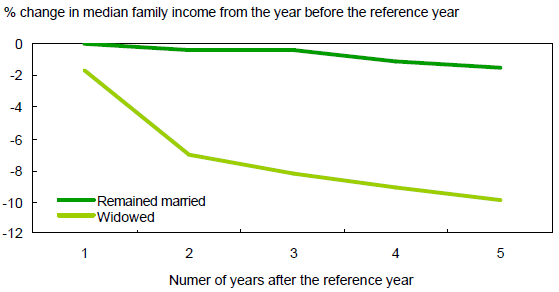
Note: The reference year is defined as the year a senior married woman’s husband
dies, which becomes the reference year for the other senior women who remained
married during that year and the following years.
Source: Longitudinal Administrative Databank, 1990 to 2001.
Canada compares favourably internationally
The financial situation of widows in Canada one year after the death of their husbands compares favourably with that of widows in the United States, Great Britain and Germany, according to a recent Statistics Canada’s study.4
An independent study5 compared the changes in the economic well-being of elderly women at widowhood in the United States and Germany using the same measures as shown in this present paper. Unfortunately, the results are not strictly comparable because of the definition in some concepts and target groups, but the paper could be of interest to researchers.
Many senior women were in low income as a result of widowhood
Many senior women slipped into low income as a result of widowhood, as measured by Statistics Canada’s Low Income Measure.
This is a strictly relative measure of low income. A woman in the low-income group in this analysis has an adjusted family income, before taxes, of less than 50% of the median adjusted total family income. The low-income rate is the proportion of senior women that are part of the low-income group.
Low-income rates were compared between two sets of senior women — those who were married and became widows, and those who were married but did not become widows.
Prior to widowhood, the low-income rate for senior women who lost their husbands in the following year was 3.6%. One year after widowhood, the low-income rate of these widows increased to 4.7%.
At the same time, the low-income rate among married women who did not become widows declined from 4.6% to only 3.3%.
In the years following widowhood, the low-income rate for widows increased year after year while the low-income rate remained relatively stable for the still married senior women.
Five years after the husband’s death occurred, proportionally, there were more low-income widows relative to their still married counterparts. The low-income rate of widows increased to 9.4%, twice the proportion of 4.8% among senior women who remained married.
The low-income rate of widows five years after widowhood (9.4%) was almost three times higher than their rate one year before the death of their husband (3.6%).
Among the widows who were below the low-income threshold one year after their husband’s death, more than three-quarters of them were not in low income the year before they became widows.
Low-income rate of widows increased continuously in the years after widowhood
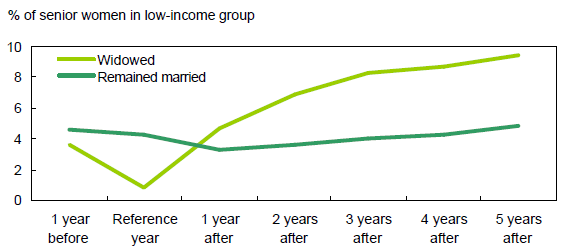
Note: Income in the year of widowhood (reference year) may not be comparable to the
years before or after since lump-sum death benefits such as life insurance and survivor
benefits are often paid to widows and may temporarily raise their income. The
reference year is defined as the year a senior married woman’s husband dies, which
becomes the reference year for the other senior women who remained married during
that year and the following years.
Source: Longitudinal Administrative Databank, 1990 to 2001.
Very difficult for senior widows to climb out of low income
Once these senior widows slipped into low income, it was very difficult for them to climb out. Five years after widowhood, about three-quarters of the widows who were below the low-income threshold one year after widowhood had not been able to get out.
Thus, the decline below the low-income threshold was temporary for only one-quarter of the widows who were part of the low-income group one year after widowhood.
While the low-income rate of widows has been increasing over the five years after widowhood, the average low-income gap has been decreasing. The low-income gap is the average amount of money required to bring senior women out of low income.
Many senior women were not part of the low-income group before widowhood. However, they were in low income afterwards. And, the average amount of money required to bring these widows above the low-income threshold has been decreasing. This means that less money per woman would be required to get them above the low-income threshold.
The average low-income gap for senior women one year before widowhood was about $2,600, or 13% less than for those who did not become widows ($3,000).
One year after widowhood, the average amount of money required to bring widows out of the low-income group dropped to $1,600. This was 38% lower than the year before widowhood.
Five years later, the average amount of money required to bring widows above the low-income threshold was about $1,300, which is 46% lower than the year before widowhood.
After the death of a husband, the average amount of money required to bring widows above the low-income threshold varied between one-half and two-thirds the average amount required to bring senior women who remained married out of the low-income group. More research would be needed to explain these differences.
Average low-income gap of widowed women is lower than for women who remained married
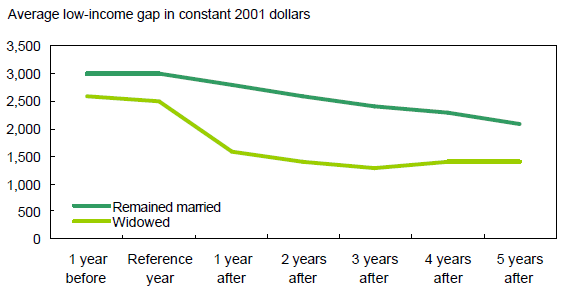
Note: Income in the year of widowhood (reference year) may not be comparable to the
years before or after since lump-sum death benefits such as life insurance and survivor
benefits are often paid to widows and may temporarily raise their income.
Source: Longitudinal Administrative Databank, 1990 to 2001.
Widows twice as likely to enter low income
Because of widowhood, more senior women were entering low-income status over the years. Five years after the death of their spouse, the proportion of widows entering the low-income status exceeded the proportion of their still married counterparts by two to one.6
One year after widowhood, 3.8% of widows had fallen below the low-income threshold. Five years after widowhood, this proportion had more than doubled to 8.1%. The proportion was significantly lower for senior women who remained married (at 3.5% five years after).7
Proportion of widows entering low income has more than doubled in five years
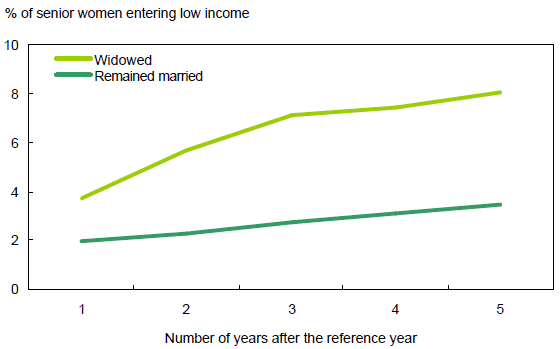
Source: Longitudinal Administrative Databank, 1990 to 2001.
At all income levels, income declined after widowhood
To obtain a breakdown of various income groups, senior widows were ranked by their family income of the year before widowhood and divided into four equal groups, or quartiles, based on their income levels. Each group, therefore, represents 25%, or one-quarter, of the total number of senior widows.
The 25% of senior widows with the lowest incomes, or the first quartile, experienced a decline in median family income of 5.6% five years after widowhood. This was the smallest decline in median family income relative to the other quartiles five years after widowhood.
This may be because the majority of their income is probably not strongly attached to their husband’s portion of the total family income. As a result, they may be more dependent on government support, protecting them from large declines in income after the death of their husband.
The one-quarter of senior women in the lower-mid income range, quartile 2, experienced the largest drop, over 12%, in median family income five years after widowhood.
The 25% of senior women with the highest incomes were not immune. They also experienced a decrease in median family income five years after widowhood amounting to almost 8%.
Median income falls for senior widows, even for high income women
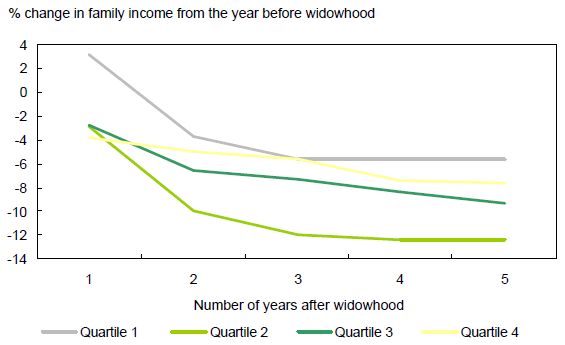
Source: Longitudinal Administrative Databank, 1990 to 2001.
Sources of income change after widowhood
Not all women experienced a decline in their family income after widowhood. In fact, over one-third (36%) experienced an increase between the year before widowhood and five years after. The sources of their gains were mainly in income from assets and other income.
Higher income from assets suggests that these widows received some sort of insurance benefits, inheritances, or transfers of ownership. These assets could result from factors other than the husband’s death but are likely to reflect financial plans made by married couples. These plans appear to make a difference for the wife who is left behind. As a result of higher income, it is not surprising that these women receive less Old Age Security.
Almost two-thirds (64%) of the senior women experienced a decline in their family income after widowhood. This decline was widespread in terms of income sources. Five years after the death of their husband, each income source contributed about 20% to the total decline, except for other transfer income. This implies that there is no source of income that compensated for their wide spread declines in income.
Widows with increased income benefited from asset income and other income

Source: Longitudinal Administrative Databank, 1990 to 2001.
Widows who suffered income decline lost out almost equally from all income sources, except other transfers

Source: Longitudinal Administrative Databank, 1990 to 2001.
Income sources definitions
Old Age Security consists of Old Age Security pension, Social Assistance income, Net Federal Supplements and non-taxable income.
Pensions comprise Canadian Pension Plan (CPP) and Quebec Pension Plan (QPP), Pension and Superannuation income and RRSP income.
Other transfers include family benefits, provincial refundable tax credit, employment insurance benefits, Goods and Services Tax (GST) and Harmonized Sales Tax (HST) credits, workers compensation payments, child tax benefits and child tax credits.
Earnings consist of employment income from T4 slips, other employment income and net self-employment income.
Asset income comprises dividends, interest and investment income and net rental income, which could represent income from assets financed with inheritances.
Other income consist of components such as retiring allowances, death benefits from employment service (less any tax free amounts), loans and transfers of property tax, amounts distributed from a retirement compensation arrangement, RRSP income for persons aged 65 and over (excluding annuities reported as pension income) and alimony or support income.
Data sources and methods
The data source for this analysis is the Longitudinal Administrative Databank (LAD). It is a 20% sample of the T1 Family File (TIFF), a yearly cross-sectional file of all tax filers and their families. Census families are created from information provided annually to the Canada Revenue Agency on personal income tax returns and / or applications for Child Tax Benefits.
The income measure used is post-transfer, before-tax income. Family income is adjusted for inflation and family composition (family size and ages of family members). The adjustment is the sum of individual factors: one adult is counted as 1, each additional adult as 0.4; and each child under age 16 is counted as 0.3 — except in a family with only one adult, where the first child is counted as 0.4.
The Low Income Measure (LIM) used is 50% of the adjusted median family income of the total population where “adjusted” indicates a consideration of family size and composition allowing for economies of scale.
The terms “in the year before” and “one year after” refer to the tax years and not the twelve month period ending with, or starting with, the death of the husband.
The results from the last section on “Source of income change after widowhood” are based on a contribution to change analysis (absolute variation in a source of income divided by the absolute change in the total).
The sample used in this study includes all women 65 years of age and over who were married or widowed during the period 1990 to 2001. The sample consists of approximately 32,000 senior widows and approximately 630,000 senior women who did not lose their husband. Widows are included in the sample until they die or re-marry. Their married counterparts include senior women who did not lose their husband in the five years following the reference year or remained married until they die or until 2001. Restricting the samples to senior women who did not change status during the five years following the reference year does not change the results of this study.
Footnotes
- Statistics Canada, 2001 Census, Legal Marital Status (6), Age Groups (19) and Sex (3) for Population, for Canada, Provinces, Territories, Census Metropolitan Areas and Census Agglomerations, 1996 and 2001 Censuses – 100% Data, Catalogue no. 97F0004XCB01001.
- See British Columbia Seniors’Advisory Council, Perspectives on Older Women in BC, Socio-Economic Change in the Making, August 1998, ISBN 0-7725–3658–3.
- See R. V. Burkhauser, P. Giles, D. R. Lillard, and J. Schwarze, “Income replacement among recent widows”, Perspectives on Labour and Income, Vol. 5, No. 5, May 2004, Statistics Canada Catalogue no. 75-001-X, p. 12-17.
- See R. V. Burkhauser, P. Giles, D. R. Lillard, and J. Schwarze, “Income replacement among recent widows”, Perspectives on Labour and Income, Vol. 5, No. 5, May 2004, Statistics Canada Catalogue no. 75-001-X, p. 12-17.
- See Thomas L. Hungerford, “The Economic Consequences of Widowhood on Elderly Women in the United States and Germany”, The Gerontologist, Vol. 41, No. 1, 2001, p. 103-110.
- Entering low-income status means that senior women went from non-low-income status prior to the reference year to low-income status afterwards. For this section only, senior women who remained widowed or married for five years after the reference year are included.
- These percentages are lower than those presented in the previous sections as they exclude senior women who were already in low income before the reference year.

